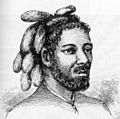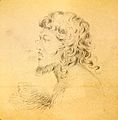Alfred Thomas Agate facts for kids
Quick facts for kids
Alfred Thomas Agate
|
|
|---|---|

Self-portrait
|
|
| Born | February 14, 1812 |
| Died | January 5, 1846 (aged 33) Washington, D.C.
|
| Nationality | American |
| Known for | Painting, Miniature |
Alfred Thomas Agate (born February 14, 1812 – died January 5, 1846) was a famous American artist. He was a painter and also created tiny, detailed pictures called miniatures.
Agate lived in New York City from 1831 to 1838. He learned art from his brother, Frederick Styles Agate, who painted portraits and historical scenes. Later, he studied with another artist named Thomas Seir Cummings.
By the late 1830s, Agate was showing his artwork at the National Academy of Design in New York. He became known as a very skilled oil painter. In 1840, he was even made an honorary member of the National Academy of Design.
Agate drew many different things. He created pictures of landscapes, portraits of people, and scientific illustrations. For many of his landscapes, Agate used a special tool called a camera lucida. This device helped him trace scenes onto paper.
Contents
Exploring the World with Art
Agate created many amazing artworks during his time with the United States Exploring Expedition. This big journey happened from 1838 to 1842. He worked under the leader of the expedition, Charles Wilkes.
Agate was especially good at drawing plants. He was chosen as the main artist for portraits and plants on the expedition.
Journey to the Pacific
The United States Exploring Expedition traveled through many islands. In 1841, they visited the Ellice Islands, including Funafuti, Nukufetau, and Vaitupu.
During this visit, Alfred Thomas Agate drew pictures of the local people. He recorded their clothing and the patterns of their tattoos. This gave us a look into their culture at that time.
Drawing New Lands
Agate drew the first known picture of Mount Shasta in California. He contributed more than half of the drawings and paintings for the expedition's official reports. Out of 342 pictures, Agate made 173 of them. These were later printed as lithographs.
He sketched many scenes in the Oregon Territory. These included a look inside a Chinook Lodge and an Indian Burial Place. He also drew an Indian Mode of Rocking Cradle. Agate even drew a picture of one of the expedition's ships after it wrecked near the Columbia River.
Life After the Expedition
After the expedition, Agate lived in Washington, D.C. from 1842. However, the long journey had made him very sick. He passed away four years later, in 1846, from a serious illness that affected his lungs.
When Agate died, his drawings went to his wife, Elizabeth Hill Kennedy Agate. She later married Dr. William J. C. Du Hamel. In 1926, one of her daughters sold the drawings to the Naval Historical Foundation. The Naval Historical Foundation then gave Agate's artwork to the Navy Art Collection in 1998.
Places Named After Agate
Some places were named to honor Alfred Thomas Agate. In 1841, Charles Wilkes named Agate Pass near Bainbridge Island, Washington, after him.
Agate Island in Fiji was also named in his honor. A botanist named Asa Gray used Agate's plant drawings for his reports. He even named a type of violet, Agatea violaris, after the artist.
Gallery
-
"Andes near Alparmarca, Peru: Sketched from an Elevation of 16,000 Feet", illustration from the South American portion of the United States Exploring Expedition, digitally restored
-
A man from the Nukufetau atoll, Ellice Islands (now Tuvalu) 1841
-
Portrait of a native of the Gilbert Islands (then called the Kingsmill Islands), 1841
-
Illustration of a Ficus in Samoa
See also
 In Spanish: Alfred Thomas Agate para niños
In Spanish: Alfred Thomas Agate para niños







